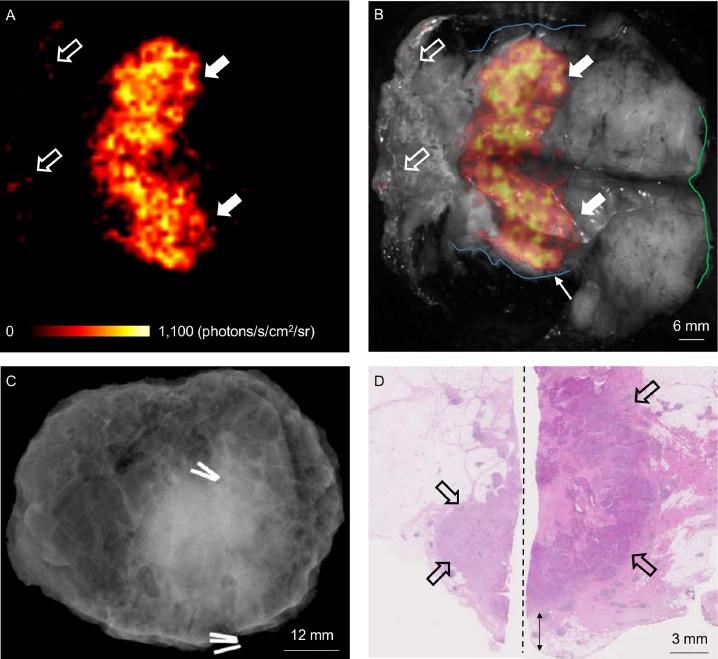LONDON, June 7, 2017 — Use of Cerenkov luminescence imaging (CLI) could provide a more accurate technique for assessing resection margins during breast-conserving surgery, a primary treatment for early-stage breast cancer. CLI combines optical and molecular imaging by detecting light emitted by a PET radiotracer F-18-fluorodeoxyglucose (F-18-FDG). CLI’s high-resolution and small-sized imaging equipment make it a promising technology for assessing tumor margins during breast tumor surgery.

This is a Cerenkov image (A); Gray-scale photographic image overlaid with Cerenkov signal (B). An increased signal from the tumor is visible (white arrows); mean radiance is 871 ± 131 photons/s/cm2/sr, mean TBR is 3.22. Both surgeons measured the posterior margin (outlined in blue) as 2 mm (small arrow); a cavity shaving would have been performed if the image had been available intraoperatively. The medial margin (outlined in green) measured >5 mm by both surgeons. Pathology ink prevented assessing the lateral margin; a phosphorescent signal is visible (open arrows). Specimen radiography image (C). The absence of one surgical clip to mark the anterior margin, and the odd position of the superior margin clip (white arrow), prevented reliable margin assessment. Combined histopathology image from two adjacent pathology slides (D) on which the posterior margin (bottom of image) and part of the primary tumor are visible (open arrows). The distance from the posterior margin measured 3 mm microscopically (double arrow). The medial margin is >5 mm (not present in image). Courtesy of A.D. Purushotham, M.D., King's College London, U.K.

“By accurately assessing tumor resection margins intraoperatively with
CLI, surgeons may be able to completely clear the cancer with a single
operation, thereby reducing the number of breast cancer patients
requiring a second, or even third, surgical procedure. Ultimately this
could lead to improved patient care and reduced health care costs if
confirmed in larger clinical studies.”
This in-human study included 22 patients with invasive breast cancer.
F-18-FDG was injected 45 to 60 minutes before surgery. Immediately after
the excision of tumors, specimens were imaged intraoperatively in an
investigational CLI imaging system. The first 10 patients were used to
optimize the imaging protocol; the remaining 12 were included in the
analysis dataset. Ten of the 12 patients had an elevated tumor radiance
on CLI. Sentinel lymph nodes were successfully detected and biopsied in
all patients.
A randomized controlled trial will evaluate the impact of the F-18-FDG CLI technique on re-excision rates.
The research was published in The Journal of Nuclear Medicine
(doi: 10.2967/jnumed.116.181032).